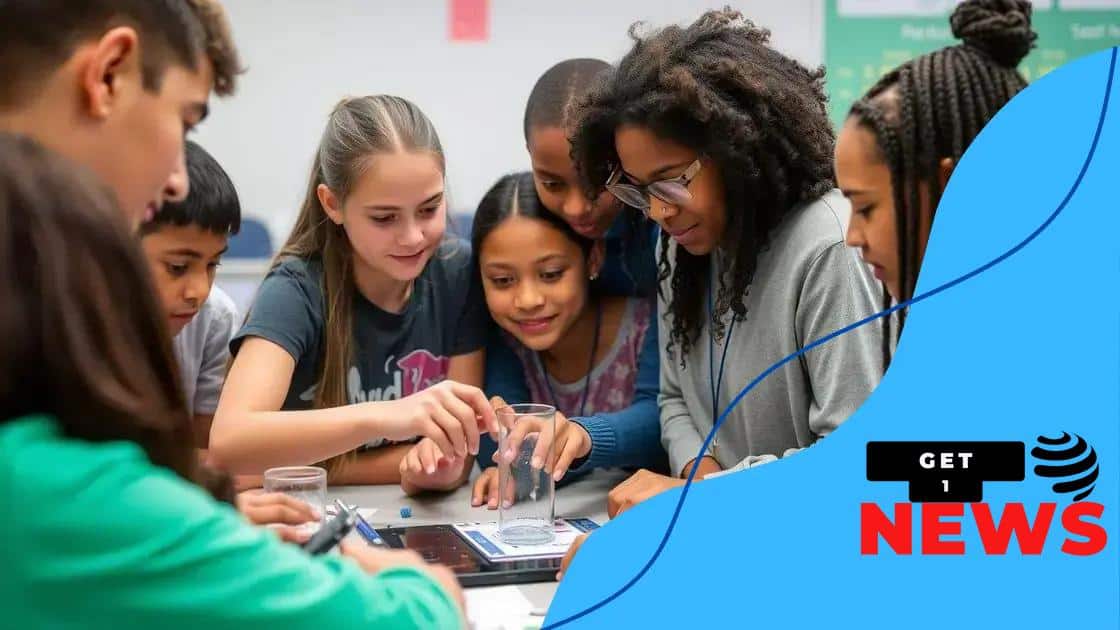STEM programs for underrepresented groups: bridging the gap

STEM programs for underrepresented groups are essential for increasing diversity, enhancing innovation, and providing equitable access to educational and career opportunities in science, technology, engineering, and mathematics.
STEM programs for underrepresented groups are essential in creating equal opportunities in the tech landscape. Have you ever thought about how diversity can drive innovation? In this article, we’ll dive into the impact and importance of these programs.
Why STEM representation matters
Understanding why STEM representation matters is crucial for fostering a more inclusive society. When diverse voices contribute to scientific and technological advancements, innovation thrives. This diversity opens the door for fresh perspectives that can lead to groundbreaking ideas.
Importance of Representation
STEM representation is not just about numbers; it influences how problems are approached and solved. When underrepresented groups participate, the solutions created are often more effective and relatable to a broader audience.
Benefits of Diversity in STEM
- Diverse teams outperform homogeneous ones in problem-solving.
- They promote creativity and innovative thinking.
- Diverse viewpoints address a wider range of issues.
- They enhance the educational experience for all students.
Moreover, when young students see scientists or engineers who look like them, they are more likely to envision themselves in those roles. This representation creates role models, offering mentorship and encouragement for future generations. It’s essential for schools and organizations to actively promote STEM programs that reach out to students from varied backgrounds.
Real-World Impact
The effects of improved STEM representation can be seen in multiple sectors. For example, companies that prioritize diversity tend to experience higher profitability and productivity. They resonate better with a diverse consumer base, leading to products and services that meet widespread needs.
Successful initiatives showcase the importance of creating environments where everyone feels welcome and valued. By investing in STEM programs aimed at supporting underrepresented populations, society at large benefits from more robust and equitable innovations.
Successful examples of STEM programs
Many successful STEM programs have made significant impacts on underrepresented communities. These programs serve as powerful examples of how targeted efforts can inspire and nurture talent among those who have been traditionally overlooked in the fields of science, technology, engineering, and mathematics.
Community-Focused Initiatives
Community-based initiatives have gained traction in recent years. These programs often collaborate with local organizations and schools to create an inclusive environment for learning. One notable example is Black Girls CODE, which aims to increase the number of women of color in technology by providing workshops and mentorship.
School Partnerships
Partnerships between schools and organizations can also lead to successful outcomes. For instance, Project Lead The Way has established a curriculum that promotes hands-on, project-based learning in engineering and computer science, reaching students in thousands of schools across the U.S.
- The curriculum is adaptable and supports a diverse range of learners.
- Students engage in real-world challenges that enhance problem-solving skills.
- This approach fosters curiosity and a love for learning in STEM fields.
Another innovative program is Girls Who Code, which has expanded to reach thousands of girls worldwide. Their summer immersion programs teach coding skills and build confidence in young women, making technology more accessible.
Companies are also stepping up. For example, Google’s Computer Science Summer Institute provides opportunities for high school seniors from underrepresented backgrounds to learn coding and develop their skills further. This initiative not only equips them with essential technical knowledge but also connects them with peers and professionals in the industry.
Global Initiatives
Globally, programs like TechGirls connect young women from the Middle East and North Africa with U.S. counterparts, fostering cultural exchanges while boosting their technical skills.
Through mentorship and hands-on learning, these successful examples illustrate that deliberately designed STEM programs can inspire future leaders in various communities, breaking down barriers and building pathways to success.
Benefits of diversity in STEM fields

The benefits of diversity in STEM fields are profound and far-reaching. When individuals from various backgrounds come together, they contribute unique perspectives and experiences, which can lead to innovative solutions and advancements in technology and science.
Enhanced Problem Solving
A diverse team often approaches challenges in different ways. This variety in thought processes leads to enhanced creativity and innovation. When people collaborate from different cultural and educational backgrounds, they are more likely to come up with solutions that are not only effective but also inclusive.
Better Representation
Having diverse voices in STEM ensures that products and technology reflect the needs of a broader population. This representation is crucial for designing technology that serves everyone. When teams are made up of individuals from different communities, potential biases can be identified and addressed, leading to fairer outcomes.
- Diversity promotes a better understanding of diverse users.
- It fosters a more equitable tech landscape.
- Innovations benefit from being tested by varied groups.
- Product development is more responsive to real-world needs.
Moreover, diversity in STEM leads to improved employee satisfaction and retention. Teams that celebrate inclusivity and respect individual backgrounds create a more positive work environment. Employees feel valued and engaged, which often boosts productivity and success.
Research shows that companies with diverse teams are more profitable. They are better equipped to meet market demands and respond to customer needs. Therefore, investing in diversity initiatives within STEM not only benefits individuals but also enhances organizational performance.
Fostering Future Leaders
Encouraging diversity in STEM helps prepare the future workforce. When students see role models who represent them, they are more likely to pursue careers in these fields. This change encourages the next generation to be part of the solution, contributing to a more balanced and equitable future.
Challenges faced by underrepresented groups
Underrepresented groups in STEM face numerous challenges that can hinder their success. These challenges range from systemic issues to personal obstacles, making it essential to address them effectively.
Systemic Barriers
One significant challenge is systemic bias within educational and professional environments. Many underrepresented individuals encounter stereotypes that can discourage them from pursuing STEM careers. This bias can manifest in various forms, including limited access to advanced courses and mentorship opportunities.
Lack of Representation
The lack of role models in the field can have a profound impact on motivation. When students do not see professionals who look like them in STEM, they may feel isolated or question their ability to succeed. This absence of representation often leads to feelings of belongingness and can greatly affect self-esteem.
- Low participation rates in STEM programs.
- Higher dropout rates among diverse students.
- Fewer networking opportunities for minority students.
Additionally, financial constraints pose a challenge for underrepresented groups. Many students may lack the resources to pursue advanced degrees or attend specialized programs that could enhance their skills. Scholarships and financial aid can play a crucial role, but they are not always sufficient or accessible to those in need.
Cultural factors can also contribute to the challenges faced by these individuals. For example, some students from different backgrounds may prioritize family obligations over academic pursuits. Balancing these demands can be difficult and may lead to lower academic performance in STEM subjects.
Support Systems
It’s important to recognize that support systems are vital for overcoming these challenges. Mentorship programs and community support can greatly improve the chances of success for underrepresented students. Connecting them with mentors who understand their experiences can help them navigate their academic and professional paths more effectively.
Future of STEM inclusivity initiatives
The future of STEM inclusivity initiatives looks promising as more organizations recognize the importance of diversity in these fields. By fostering an inclusive atmosphere, they can enhance innovation and creativity. With ongoing efforts, the landscape is evolving to better support underrepresented groups.
Emerging Trends
One significant trend is the growth of partnerships between schools, non-profits, and companies. These collaborations aim to create pathways for students from diverse backgrounds to succeed in STEM. Programs like after-school workshops and summer camps are gaining popularity, allowing students to explore fields such as coding, robotics, and engineering.
Funding and Resources
Funding is also becoming more accessible for inclusive STEM programs. Many organizations are increasingly providing grants specifically aimed at enhancing diversity initiatives. These resources help schools and community organizations develop specialized programs that cater to the unique challenges faced by underrepresented students.
- Grants for mentorship programs.
- Financial aid for STEM workshops.
- Support for student-led STEM projects.
Advancements in technology play a crucial role in shaping these initiatives. Online platforms and resources enable access to a wider audience. Students from remote areas can participate in virtual classes and workshops, leveling the playing field for education in STEM-related topics.
Moreover, the push for corporate responsibility is growing. Companies are increasingly held accountable for their diversity efforts and are investing in community programs. This change will not only benefit the companies but also enrich the entire STEM ecosystem by encouraging diverse talents to enter the workforce.
Long-Term Impact
Long-term, these inclusivity initiatives will likely create a more diverse workforce in STEM fields. As underrepresented individuals gain access to education and job opportunities, they can contribute valuable perspectives and skills. This shift is crucial for addressing the global challenges we face today, making it imperative to invest in diversity within STEM.
FAQ – Frequently Asked Questions about STEM Inclusivity Initiatives
What are STEM inclusivity initiatives?
STEM inclusivity initiatives are programs and efforts aimed at increasing participation and representation of underrepresented groups in science, technology, engineering, and mathematics.
Why is diversity important in STEM fields?
Diversity in STEM leads to more innovation, as individuals from different backgrounds bring unique perspectives and ideas that can enhance problem-solving and creativity.
How can schools support underrepresented students in STEM?
Schools can support these students through mentorship programs, partnerships with organizations, and by providing access to resources and opportunities in STEM education.
What role do companies play in promoting STEM inclusivity?
Companies can play a crucial role by investing in community programs, providing scholarships, and creating internships that target underrepresented groups, making a positive impact on the future workforce.





